Here’s Why Black Holes Are Crullers, Not Donuts

When you measure not just light, but light’s polarization, you learn so much more.
It’s been over 100 years since the first solution for a black hole was discovered in General Relativity. For generations, scientists argued over whether these objects were physical, existing all throughout our Universe, or whether they were mere mathematical artifacts. In the 1960s, Roger Penrose’s Nobel-winning work demonstrated how black holes could realistically form in our Universe, and shortly thereafter, the first black hole — Cygnus X-1 — was discovered.
Black holes are now known to range from just a few times the mass of our Sun up to many billions of solar masses, with most galaxies housing supermassive black holes at their centers. In 2017, a tremendous observing campaign was coordinated between a large number of radio telescopes around the world in an attempt to directly image a black hole’s event horizon for the first time. That first image was released in 2019, revealing a donut-like shape surrounding the interior void. Now, a new series of papers has improved upon that image, and we can see it’s not a donut, but rather a cruller, with sweeping magnetic “lines” tracing out the hot plasma. Here’s the new science behind this epic image, and why black holes are crullers, not donuts.
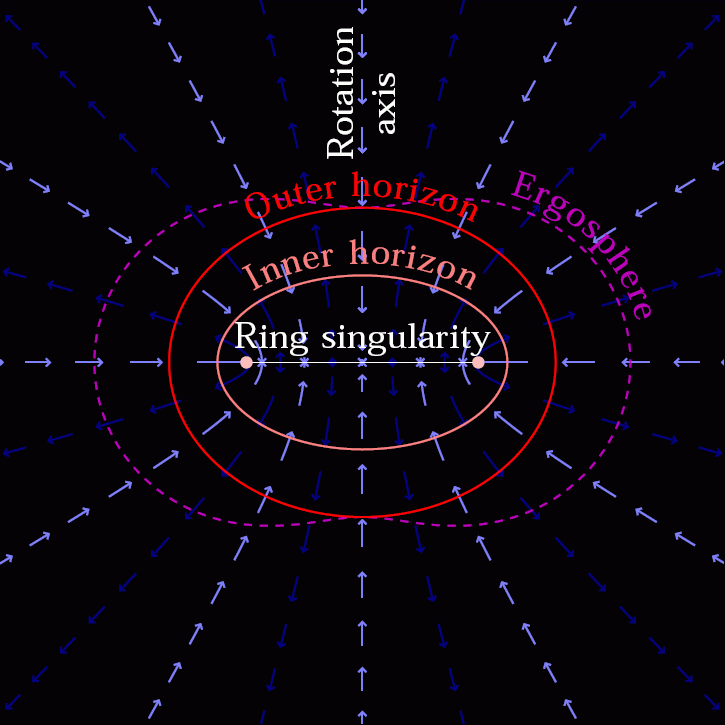
In our Universe, black holes aren’t merely clumps of mass that have collapsed under their own gravity to a single point. In space, all forms of matter exert gravitational forces on one another, and whenever objects interact in this way, they attract the “closer” parts of the object by a greater amount than the “farther” parts of it. This type of force — known as a tidal force — isn’t just responsible for tides, but also for causing a torque: a change in the angular momentum of an object. As a result, everything that exists in the Universe rotates, or spins, rather than remaining stationary.
This means that the black holes that we form aren’t stationary and non-rotating, but rather spin about some axis. Indirect measurements had previously indicated that black holes spin relativistically: close to the speed of light. However, the major idea of the Event Horizon Telescope is that, regardless of how this spinning black hole is oriented, there will be light emitted from the surrounding matter that just “grazes” the event horizon, and goes off in a straight line, creating a photon ring for us to observe that encircles the dark center, from where no light can escape. (For reasons related to the curvature of space, the size of this dark center is actually more like ~250% the diameter of the physical event horizon.)
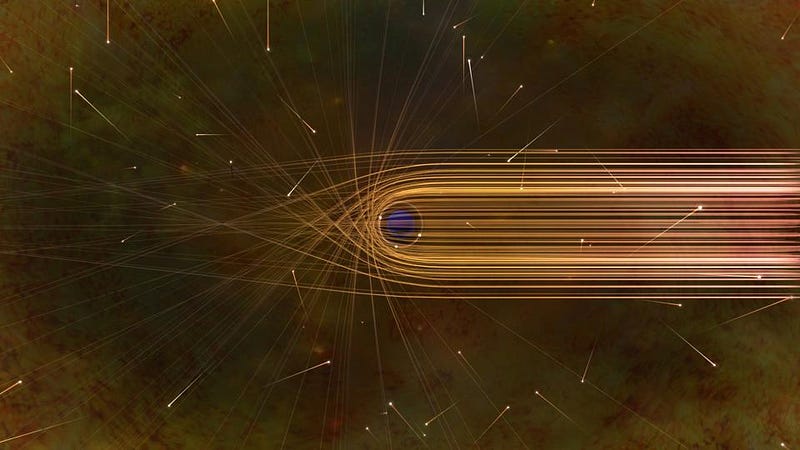
The way we went about imaging this was a tremendous technological achievement. We needed to take an array of radio images (at millimeter-submillimeter wavelengths) from all around the globe at once. This gave us the light-gathering power of all the telescopes that were part of the array, combined, but gave us the resolution of the maximum separation between the various telescopes, which was roughly the diameter of Earth.
In order to see anything, then, we had to look for black holes that were simultaneously very large, with a large angular diameter as seen from our perspective on Earth, and were also active: emitting copious amounts of radiation at radio wavelengths. There are only two that fit the bill:
- Sagittarius A*, the four million solar mass black hole at the center of our galaxy, just ~27,000 light-years away.
- And the black hole at the center of the massive elliptical galaxy M87, which comes in at 6.5 billion solar masses (some 1500 times the mass of Sagittarius A*), but some 50–60 million light-years distant (about 2000 times as far).
In April of 2019, after two years of analysis, the first images were released: a map of the radio light that traced out the emitted photons from around the black hole in the distant galaxy M87.
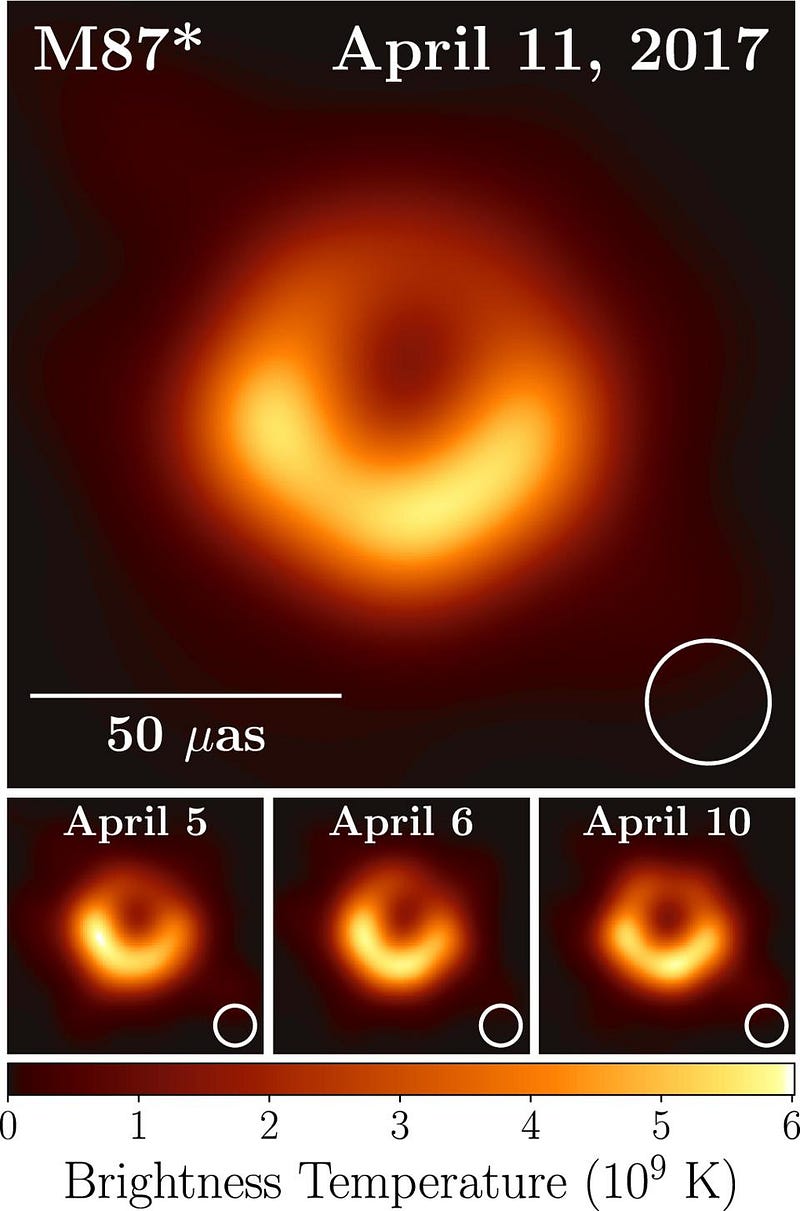
Even though this is usually depicted as a single image — where only the best of the four images from the four different days is shown — it’s important to recognize what’s actually happening here. Light from a very distant source is striking our telescopes at many different locations on Earth. In order to make sure we’re adding the data from the same exact times together, we have to sync up the various observatories with atomic clocks, and then account for the light-travel time to each unique point on Earth’s surface. In other words, we need to make sure that the telescopes are properly synchronized: a tremendously difficult task.
The reason we have an image of the black hole at the center of M87 and not one of the black hole in our own galaxy’s center is because of its remarkable size. At 6.5 billion solar masses, its diameter is approximately one light-day, meaning that the features in the photon ring take about ~1 day to change appreciably. At just 0.15% of that black hole’s mass, our black hole’s features change by that same amount every single minute, making the image much more difficult to construct.
However, while the Event Horizon Telescope team is still working on our black hole’s first image, the one at the center of M87 has just gotten a far more detailed image thanks to a special set of measurements that were also taken: polarization measurements.
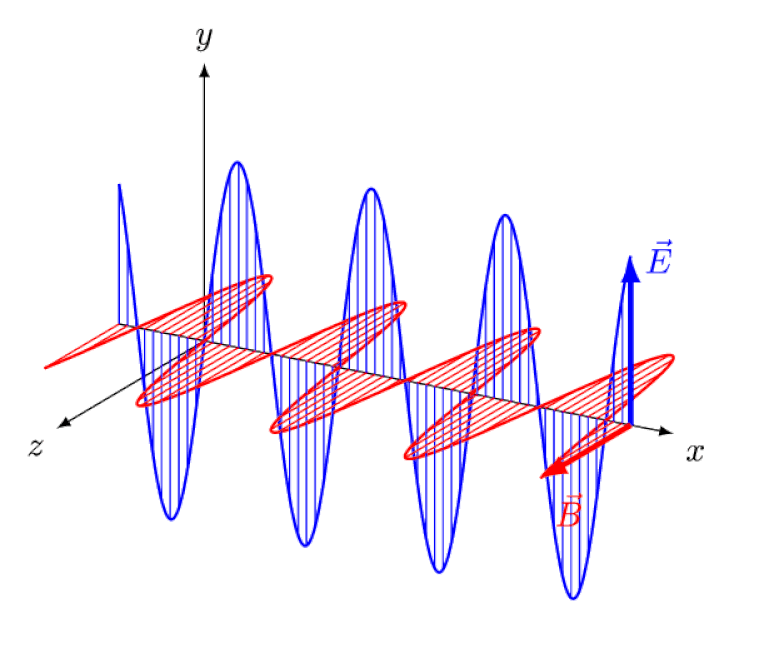
Whether you view them in a quantum way (as photons) or in a classical way (as waves), the phenomenon of light behaves with intrinsic electromagnetic properties. As an electromagnetic wave, light is made of oscillating, in-phase, mutually perpendicular electric and magnetic fields. Whenever light either, passes through a magnetized plasma or reflects off of a material, it can become partially or completely polarized: where instead of having the electric and magnetic fields oriented randomly, they’re preferentially oriented in a particular direction.
Around pulsars — radio-emitting neutron stars with very strong magnetic fields — light can be almost 100% polarized. We’d never measured the polarization of photons from around a black hole before, but in addition to simply measuring the flux and density of photons, the Event Horizon Telescope also measured the information required to reconstruct the polarization data for the black hole at the center of M87.
Just as we were able to reconstruct images of the black hole’s photon ring that evolved with time, so too could we reconstruct polarization data on that individual, day-by-day basis.
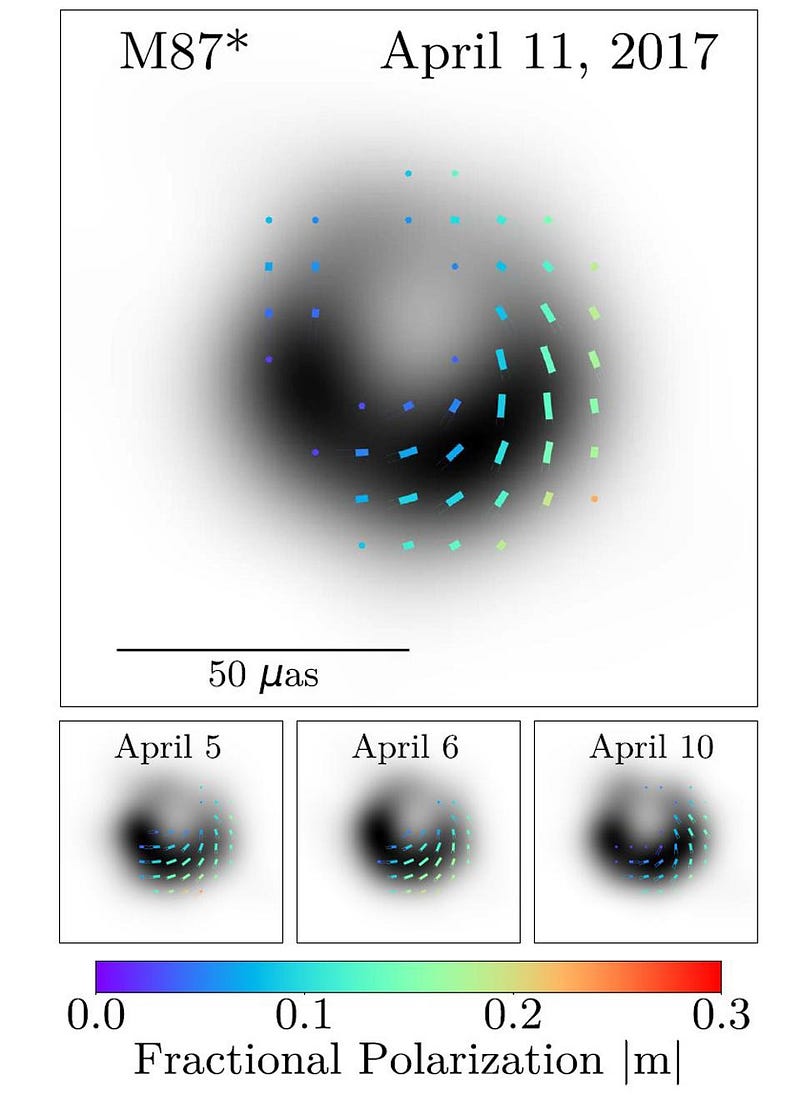
The polarization data is completely complementary to the direct light received, as it gives information that’s independent of the shape and density of the light emitted from around the black hole. Instead, polarization data is useful for teaching us about the matter that surrounds the black hole, including what the strengths of the electric and magnetic fields are in that region, the number density of free electrons, the temperature of that hot plasma, and how much mass the black hole is consuming over time.
What we learn is fascinating, and perhaps not what many expected.
- The magnetic field strength in the vicinity of the black hole is between 1 and 30 Gauss, where ~1 Gauss is the strength of Earth’s magnetic field at the surface. Compared to neutron stars, where fields can reach more than 10¹⁵ Gauss, this is minuscule, but on much larger scales.
- There are between ten thousand and ten million free electrons in every cubic centimeter around this black hole.
- The temperature of the plasma that has accreted around this black hole is enormous: between 10 and 120 billion K, or more than 1000 times the temperature at the center of the Sun.
- And finally, this black hole is consuming mass at a rate that’s between 100 and 700 Earth masses every single year.
Still, as exciting as this is, the greatest sight of all was the new image of the radiation around the black hole, with the effects of polarization (which are aligned with the electric fields and perpendicular to the magnetic fields, but everything is affected by the severely curved spacetime geometry) included.
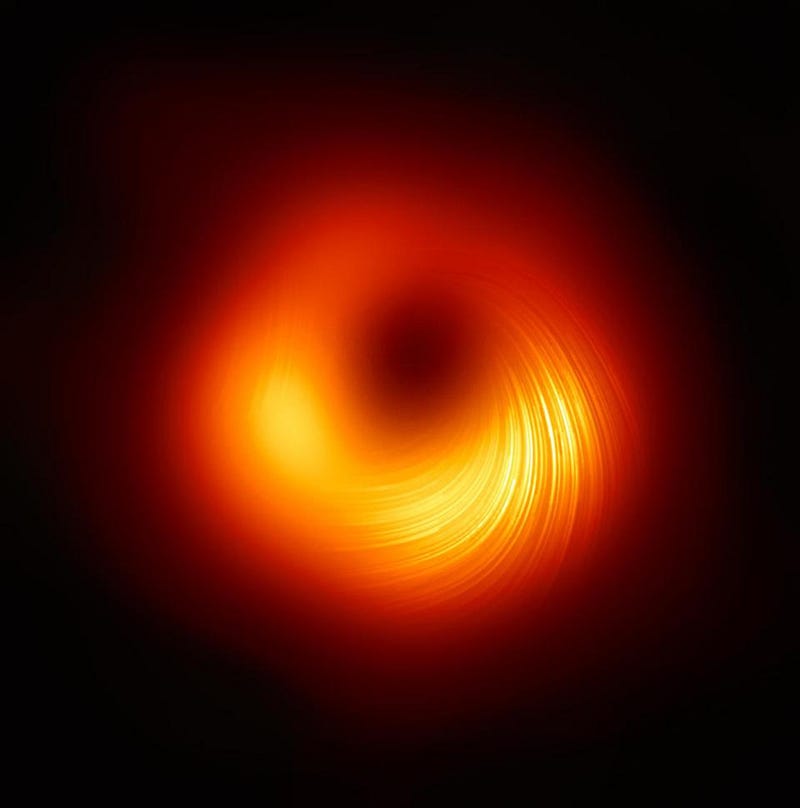
The first thing you’ll notice — and you might even worry about it — is that these swirling features appear so much sharper than the original image, which looked more like a blurry ring than anything else. Why would this polarization data, which was taken with the same instruments as the regular light data, have such a high resolution?
The answer is: surprisingly, it doesn’t. The polarization data has the same resolution as the regular data, meaning it can resolve features down to about ~20 micro-arc-seconds. There are 360 degrees in a full circle, 60 arc-minutes in each degree, 60 arc-seconds in each arc-minute, and one million micro-arc-seconds in each arc-second. If you were able to view the Apollo mission manual that was left on the Moon from Earth, 20 micro-arc-seconds would span roughly the “Ap” from the word Apollo.
What the polarization data tells us, however, is how much the light twists and in which direction, which allows us to trace out the electric and magnetic fields around the black hole. Just as we see the light and the polarization data evolving over time, we can put those results together, and determine how the photon ring around the black hole’s event horizon has changed and evolved during the course of our observations.
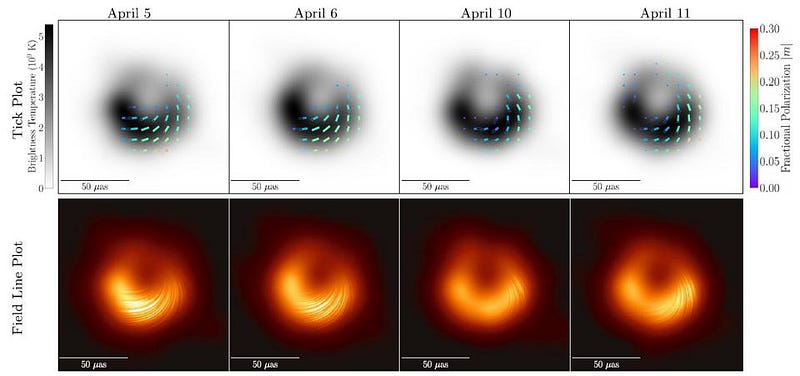
One of the big surprises is how small the photon polarization is. If you have a magnetized plasma surrounding this black hole — and we’re pretty certain that we do — you’d naively expect that the light would arrive almost completely polarized: with polarization fractions of 80–90% or even more. And yet, what we see is that the polarization fraction is tiny: about ~15–20% at its peak, with the actual value being even smaller in most locations.
Why would this be the case?
Unlike pulsars, where the magnetic field can be coherent on scales comparable to the size of the neutron star (about ~10 kilometers), this black hole is absolutely enormous. At about 1 light-day in diameter (about 0.003 light-years) for the black hole, there’s almost certainly a complicated magnetic structure on smaller scales than that. When light passes through a magnetic field, its polarization direction rotates, and rotates proportionally to the strength of the field. (This is known as Faraday rotation.)
However, if that magnetic field is non-uniform, the rotating polarization should “scramble” the signal, reducing its magnitude significantly. If we want to accurately map out the magnetic field, we’d need to leave Earth: building a similar telescope array that was larger than the diameter of our planet.
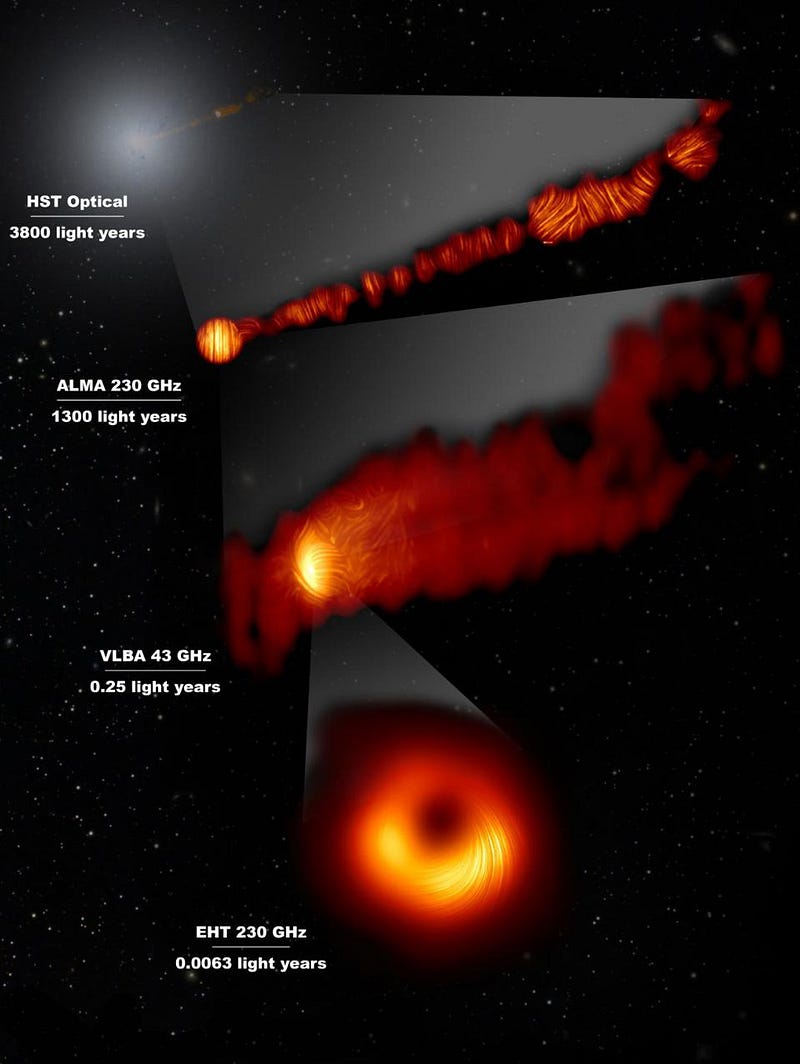
Still, none of this should diminish just how remarkable an achievement this is. By combining the effects of the light we directly observed with the polarization data, we can more accurately map out the behavior of the light emitted from this supermassive black hole: quite possibly the most massive supermassive black hole within ~100 million light-years of Earth.
When the data from the black hole at our own galaxy’s center is finally put together properly, we should have an incredibly interesting comparison to make. Right now, there are a slew of open questions, including:
- will the same parts of the black hole remain “bright” and “dark” over time, or will the accretion flows migrate to all directions in space?
- how large is the magnetic substructure around the black hole compared to the event horizon, and is it consistent between supermassive and ultra-mega-supermassive black holes?
- will we observe a larger polarization fraction for smaller mass black holes, and will that teach us anything about Faraday rotation?
- will there be comparable temperatures, magnetic field strengths, and electron densities between these two black holes, or will they be different?
Perhaps most importantly, will our theoretical calculations, borne out through simulations that incorporate all the relevant physics, match the reconstructed data to the extraordinary degree that they aligned for the black hole at the center of M87?
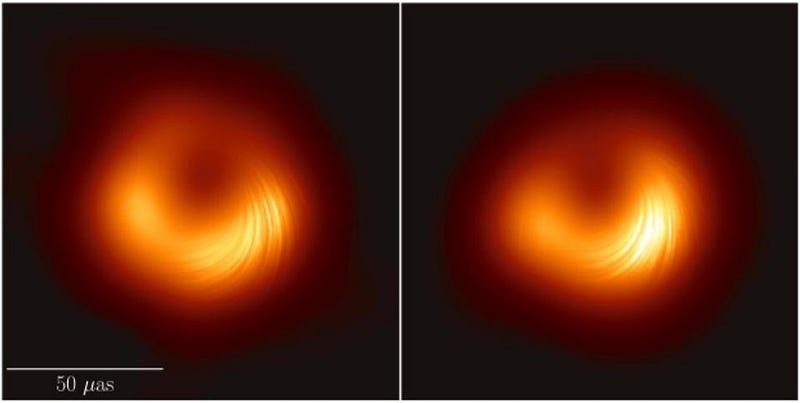
Just a few years ago, we didn’t even know whether it was a certainty that black holes had an event horizon, as we’d never observed one directly. In 2017, a series of observations were finally taken that could settle the issue. After a wait of two years, the first direct image of a black hole was released, and it showed us that the event horizon was, in fact, real as predicted, and that its properties agreed with Einstein’s predictions.
Now, another two years later, the polarization data has been added into the fold, and we can now reconstruct the magnetic properties of the plasma surrounding the black hole, along with how those features are imprinted onto the emitted photons. We still only have the one black hole that’s been directly imaged, but we can see how the light, the polarization, and the magnetic properties of the plasma surrounding the event horizon all change over time.
From over 50 million light-years away, we’re finally beginning to understand how the most massive, active black holes in the Universe work: powered by over 100 Earth masses per year and driven by the combination of Einstein’s gravity and electromagnetism. With a little bit of luck, we’ll have a second black hole that’s very different to compare it to in only a few months.
Starts With A Bang is written by Ethan Siegel, Ph.D., author of Beyond The Galaxy, and Treknology: The Science of Star Trek from Tricorders to Warp Drive.




